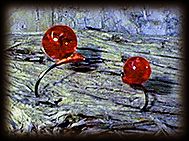Innovation is a key ingredient in most fly fishers list of skills. Whether it involves creating an original pattern or modifying an existing one to new conditions, versatility and problem-solving talents are useful, at home on the vise or along streamside.
The imitation egg is one of the most successful patterns used by Alaskan flyfishermen. Nearly every stream or river which flows to the sea supports one or more species of salmon runs and native residents like rainbow trout, arctic char or Dolly Varden, grayling and whitefish rely heavily on salmon eggs as a vital source of protein and carbohydrates during their late summer and fall feeding frenzy in preparation for winter.
This pattern, tied by Brad Hanson, has exceptional realism in imitating nature and is very simple to tie. Its versatility is enhanced by the wide variety of colors available in glass and plastic beads and as the astute flycaster knows, there are important decisions to be made in choosing the correct color to match what is occurring in the stream. There are subtle variations in the color and size of salmon eggs between species as well as a difference between the color of fresh spawned and fertile eggs and those which are dead and beginning to decay.
The beads used to tie the Bead Egg pattern are readily available and come in a multitude of colors, shades, and sizes; translucent and opaque. Pearlescent fingernail polish can be added to give a sheen similar to the membranous sack that hold eggs in the skein, or a small tuft of white marabou can also be added to enhance this effect. The beads can also be painted to achieve custom shades that are effective but not commercially produced. The potential variety of bead egg patterns is only limited by the imagination of the tyer.
|

|
1. Body - glass or plastic bead
2. Thread - Match bead color
3. Hook - #6 - #10 egg hook depending on bead size
4. Monofilament - 10-15 lb. test
|
TYING:
- Apply a thread base to the hook shank halfway from the eye to the start of the curve.
- Tie in a 12" piece of 10# - 15 # monofilament laying it flat along the top of the shank with one end starting at the eye and the length of the mono extending rearward out the back leaving one free end. Firmly wrap this down on top of the base formed in step one.
- Slip a bead onto the free end of the mono that's extending rearward, then bring the free end back toward the eye and tie it down on top of step two. Tie this in at the halfway point on the base wrap's and leave a few inches extending over the eye to grab hold of. During this step apply 3 - 4 firm wraps to tie the free end down letting the bead dangle on the large loop that's been formed. The wraps should be firm but still allow the mono to be pulled underneath with mild effort.
- Pull the portion of the mono which extends over the eye through the wraps drawing the bead into the base wrap, leaving the remaining free mono extending out the front. When the bead is pulled tightly against the base, reposition if necessary to leave the bead sitting squarely on top of the hook shank just behind the eye. Make several firm wraps in front of the egg to secure it into this position.
- Double back the remaining free section of mono along the shank of the hook towards the rear. Make several firm wraps completely covering the mono between the egg and eye of the hook. Whip finish and cut the mono where it extends rearward from the wraps underneath the bead.
Note: Step 5 was developed to prevent stripping off beads on fish that had taken the fly but during the hook set the point didn't find purchase and the fish held the bead resulting in the mono being pulled from the wraps and the bead being lost.
Glass or plastic beads are generally found in fly shops or hobby & crafts stores and have an assortment of colors and sizes. For fishing deeper or faster waters, glass beads are heavier and will sink quicker than plastic.
The strength of this pattern allows full exposure of the hook during a strike and results in more hookups than those patterns which are tied with other materials that reduce the bite of the hook.
Pattern by Brad Hanson
Photo by B. Hanson ©1999



